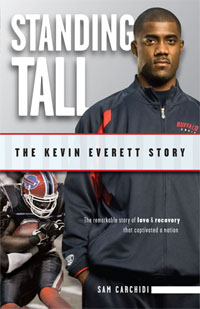Blue dye and cold can save your neck


While most reporters reacted to this with cute pictures of blue mice or references to blet M&Ms (the dye is used to color the candy), the science behind it set my mind to thinking of Kevin Everett. (Here he is on the cover of his autobiography, available in paperback from Amazon.com.)
Two years ago Everett was playing for the Buffalo Bills, just down the road from Rochester, when he suffered a career-ending spinal cord injury while making an open field tackle.
Doctors immediately applied hypothermia -- dropping his body temperature dramatically -- which probably made it possible for him to walk again.
What happens right after a spinal injury, the Rochester scientists write, is that a molecule called adenosine triphosphate (ATP) goes to work, pouring energy into the injured cells. Trouble is the cells overdose. Many die, and their death makes the paralysis permanent.
So what medicine needs is something to slow the progress of ATP down, keeping the nerve cells alive, giving future recovery a chance. Cold is one way to do it. BBG is another.
What's great about BBG is that it can be injected anywhere and get right to work. Other agents, like oxydized oxidized ATP, have to be injected at the site of the injury. That's dangerous, and failure to inject properly is dangerous as well.
Neither technique offers much hope to those who are already paralyzed. Once spinal cords die we don't know how to bring them back to life. But they do point toward a protocol that might keep you from becoming paralyzed after, say, a car crash.
They'll get you cold as ice and tangled up in blue.